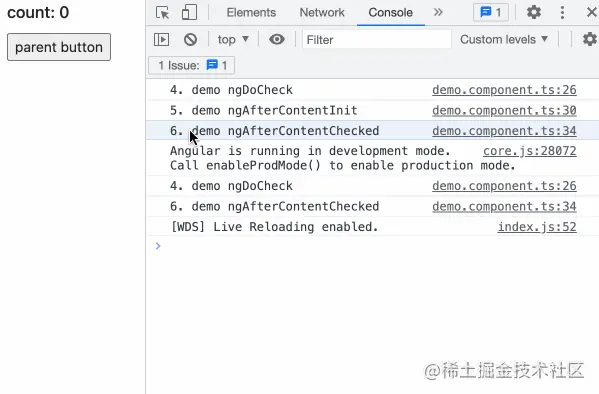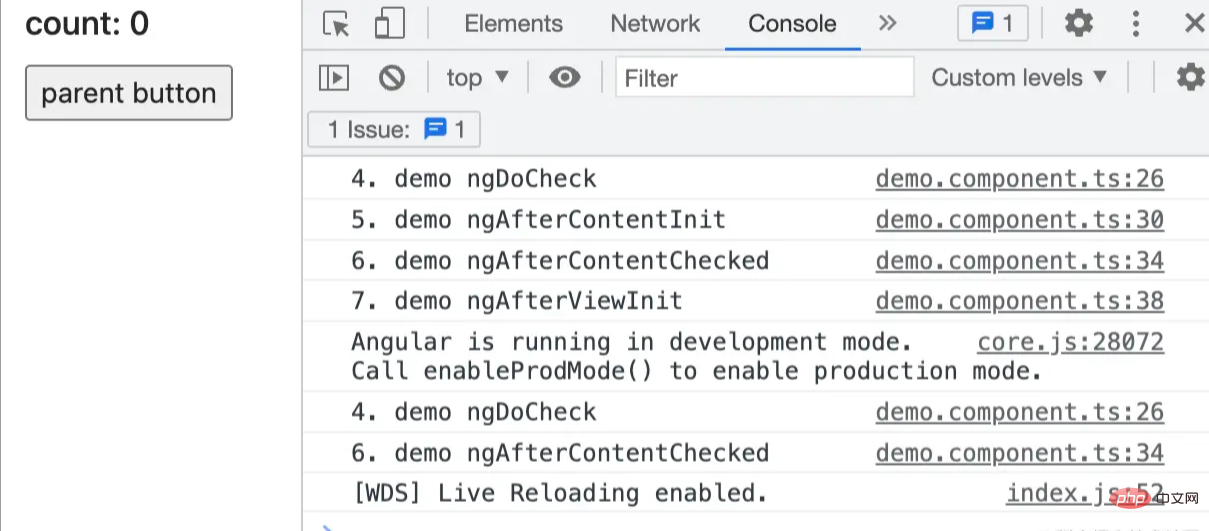Angular의 생명주기에 대해 이야기하는 기사
- 青灯夜游앞으로
- 2022-05-06 10:58:034020검색
Angular를 개발에 사용하다 보면 생명주기와의 접촉은 불가피합니다. 이번 글에서는 Angular의 생명주기에 대해 이야기해보겠습니다.

react 및 vue 개발에 노출된 독자라면 라이프사이클 개념에 익숙할 것입니다. angular를 사용하는 개발 과정에서는 이를 피할 수 없습니다. [관련 튜토리얼 추천: "react 和 vue 开发的读者应该对生命周期这个概念不陌生。我们在使用 angular 开发的过程中,是避免不了的。【相关教程推荐:《angular教程》】
组件从开始建立到销毁的过程中,会经历过一系列的阶段。这就是一个生命周期,这些阶段对应着应用提供的 lifecycle hooks。
那么,在 angular 中,这些 hooks 都有哪些呢?了解它们,对你编写程序应该在哪里编写,很重要。
angular 中,生命周期执行的顺序如下:
- constructor 【常用,不算钩子函数,但是很重要】 - ngOnChanges【常用】 - ngOnInit【常用】 - ngDoCheck - ngAfterContentInit - ngAfterContentChecked - ngAfterViewInit【常用】 - ngAfterViewChecked - ngOnDestroy【常用】
为了解说和验证,我们用 angular-cli 生成一个 demo 项目。
constructor
在 es6 中的 class 初始化对象的时候,constructor 会立即被调用。
class Person {
constructor(name) {
console.log('be called')
this.name = name;
}
}
let jimmy = new Person('jimmy'); // be calledangular 的组件本身就是导出一个类。当这个组件被 new 起来的时候,会获取 constructor 中的预设的值。
ngOnChanges
当我们有外部参数更改的时候,我们就会执行 ngOnChanges,也就是说组件中有 @Input 所绑定的属性值发生改变的时候调用。
简单说,父组件绑定子组件中的元素,会触发这个钩子函数,可以多次出发。这在下面的 ngOnInit 总会介绍。
ngOnInit
这个方法调用的时候,说明组件已经初始化成功。在第一次 ngOnChanges() 完成之后调用,且只调用一次。
// app.component.ts
export class AppComponent implements OnInit, OnChanges {
constructor() {
console.log('1. constructor')
}
ngOnChanges() {
console.log('2. ngOnChanges')
}
ngOnInit() {
console.log('3. ngOnInit')
}
}打印的信息如下:

咦?怎么没有打印 ngOnChanges 中的钩子函数信息呢?
上面已经说过了,需要触发条件 @Input 的属性值改变的时候。我们来修改一下:
<!-- app.component.html --> <div> <app-demo></app-demo> </div>
// app.component.ts // AppComponent 类中添加属性 public count:number = 0;
<!-- demo.component.html -->
<h3>count: {{ count }}</h3>// demo.component.ts
export class DemoComponent implements OnInit, OnChanges {
@Input()
public count: number;
constructor() {
console.log('1. demo constructor')
}
ngOnChanges() {
console.log('2. demo ngOnChanges')
}
ngOnInit() {
console.log('3. demo ngOnInit')
}
}
当通过 @Input 将值传递给子组件 demo 的时候,就会触发 demo 组件中的 ngOnChanges。
当 @Input 传递的属性发生改变的时候,可以多次触发 demo 组件中的 ngOnChanges 钩子函数。
<!-- app.component.html --> <div> <app-demo [count]="count"></app-demo> <button (click)="parentDemo()">parent button</button> </div>
// app.component.ts
parentDemo() {
this.count++;
}
ngDoCheck
当发生变化检测的时候,触发该钩子函数。
这个钩子函数,紧跟在每次执行变更检测时候 ngOnChanges 和首次执行执行变更检测时 ngOnInit 后面调用。
// demo.component.ts
ngDoCheck() {
console.log('4. demo ngDoCheck')
}

这个钩子函数调用得比较频繁,使用成本比较高,谨慎使用。
一般使用 ngOnChanges 来检测变动,而不是 ngDoCheck
ngAfterContentInit
当把外部的内容投影到内部组件,第一次调用 ngDoCheck 之后调用 ngAfterContentInit,而且只调用一次。
// demo.component.ts
ngAfterContentInit() {
console.log('5. demo ngAfterContentInit');
}
ngAfterContentChecked
ngAfterContentChecked 钩子函数在每次 ngDoCheck 之后调用.
// demo.component.ts
ngAfterContentChecked() {
console.log('5. demo ngAfterContentChecked');
}
ngAfterViewInit
视图初始化完成调用此钩子函数。在第一次 ngAfterContentChecked 之后调用,只调用一次。
这个时候,获取页面的 DOM 节点比较合理
// demo.compoent.ts
ngAfterViewInit() {
console.log('7. demo ngAfterViewInit');
}
ngAfterViewChecked
视图检测完成调用。在 ngAfterViewinit 后调用,和在每次 ngAfterContentChecked 之后调用,也就是在每次 ngDoCheckangular Tutorial
수명 주기 후크에 해당합니다. 🎜🎜그럼 angular의 훅은 무엇인가요? 프로그램을 작성해야 하는 위치에 대해서는 이를 이해하는 것이 중요합니다. 🎜🎜angular에서 라이프사이클 실행 순서는 다음과 같습니다. 🎜// demo.component.ts
ngAfterViewChecked() {
console.log('8. ngAfterViewChecked')
}🎜설명과 확인을 위해 angular-cli를 사용하여 데모 프로젝트 . 🎜<h3 data-id="heading-0">생성자</h3>🎜<code>es6의 클래스가 객체를 초기화할 때 생성자 즉시 호출됩니다. 🎜<!-- app.component.html --> <app-demo [count]="count" *ngIf="showDemoComponent"></app-demo> <button (click)="hideDemo()">hide demo component</button>🎜
angular의 구성 요소 자체는 클래스를 내보냅니다. 이 구성 요소가 새인 경우 생성자에서 기본값을 가져옵니다. 🎜ngOnChanges
🎜외부 매개변수가 변경되면ngOnChanges를 실행합니다. 이는 @Input 구성 요소에 가 있음을 의미합니다. 는 바인딩된 속성 값이 변경될 때 호출됩니다. 🎜🎜간단히 말하면, 상위 구성 요소가 하위 구성 요소의 요소를 바인딩하면 이 후크 기능이 트리거되고 여러 번 시작될 수 있습니다. 이는 항상 아래 ngOnInit에 소개되어 있습니다. 🎜ngOnInit
🎜 이 메서드가 호출되면 구성 요소가 성공적으로 초기화되었음을 의미합니다. 첫 번째ngOnChanges()가 완료된 후 한 번만 호출됩니다. 🎜// app.component.ts
public showDemoComponent: boolean = true;
hideDemo() {
this.showDemoComponent = false
}🎜인쇄된 정보는 다음과 같습니다. 🎜🎜 🎜🎜어?
🎜🎜어? ngOnChanges의 후크 기능 정보가 인쇄되지 않는 이유는 무엇입니까? 🎜🎜위에서 언급한 것처럼 @Input의 속성 값이 변경되면 트리거 조건이 트리거되어야 합니다. 수정해 보겠습니다: 🎜// demo.component.ts
ngOnDestroy() {
console.log('9. demo ngOnDestroy')
}rrreeerrreeerrreee🎜 🎜🎜
🎜🎜@Input을 통해 하위 구성 요소인 demo에 값이 전달되면 demo 구성 요소의 는 ngOnChanges가 실행되었습니다. 🎜🎜@Input에 의해 전달된 속성이 변경되면 demo 구성 요소의 ngOnChanges 후크 기능이 여러 번 트리거될 수 있습니다. 🎜rrreeerrree🎜 🎜ngDoCheck🎜변경 감지가 발생하면 이 후크 기능이 트리거됩니다. 🎜🎜이 후크 함수는 변경 감지가 수행될 때마다
🎜ngDoCheck🎜변경 감지가 발생하면 이 후크 기능이 트리거됩니다. 🎜🎜이 후크 함수는 변경 감지가 수행될 때마다 ngOnChanges가 수행되고 처음으로 변경 감지가 수행될 때 ngOnInit 직후에 호출됩니다. 🎜rrreee🎜 🎜🎜 이 Hook 함수는 더 자주 호출되고 사용 비용이 더 많이 들기 때문에 주의해서 사용하세요. 🎜
🎜🎜 이 Hook 함수는 더 자주 호출되고 사용 비용이 더 많이 들기 때문에 주의해서 사용하세요. 🎜🎜일반적으로 ngDoCheck 대신 ngOnChanges를 사용하여 변경 사항을 감지합니다🎜
ngAfterContentInit
🎜외부 콘텐츠를 내부 구성 요소에 프로젝션할 때 먼저를 호출하세요. <code>ngDoCheck를 여러 번, 단 한 번만 호출한 후 ngAfterContentInit. 🎜rrreee🎜 🎜ngAfterContentChecked🎜
🎜ngAfterContentChecked🎜ngAfterContentChecked 후크 함수는 각 ngDoCheck.🎜rrreee🎜 🎜
🎜ngAfterViewInit
🎜뷰 초기화가 완료된 후 이 후크 함수를 호출하세요. 첫 번째ngAfterContentChecked 이후에 한 번만 호출됩니다. 🎜🎜이번에는 페이지의 DOM 노드를 얻는 것이 더 합리적입니다🎜rrreee🎜 🎜
🎜ngAfterViewChecked
🎜보기 감지 완료 호출.ngAfterViewinit 이후에 호출되고 ngAfterContentChecked마다 호출됩니다. 즉, ngDoCheck마다 호출됩니다. 🎜// demo.component.ts
ngAfterViewChecked() {
console.log('8. ngAfterViewChecked')
}ngOnDestroy
组件被销毁时候进行的操作。
在这个钩子函数中,我们可以取消订阅,取消定时操作等等。
<!-- app.component.html --> <app-demo [count]="count" *ngIf="showDemoComponent"></app-demo> <button (click)="hideDemo()">hide demo component</button>
// app.component.ts
public showDemoComponent: boolean = true;
hideDemo() {
this.showDemoComponent = false
}// demo.component.ts
ngOnDestroy() {
console.log('9. demo ngOnDestroy')
}PS: 不知道读者有没有发现,调用一次的钩子函数都比较常用~
【完】
更多编程相关知识,请访问:编程入门!!
위 내용은 Angular의 생명주기에 대해 이야기하는 기사의 상세 내용입니다. 자세한 내용은 PHP 중국어 웹사이트의 기타 관련 기사를 참조하세요!



